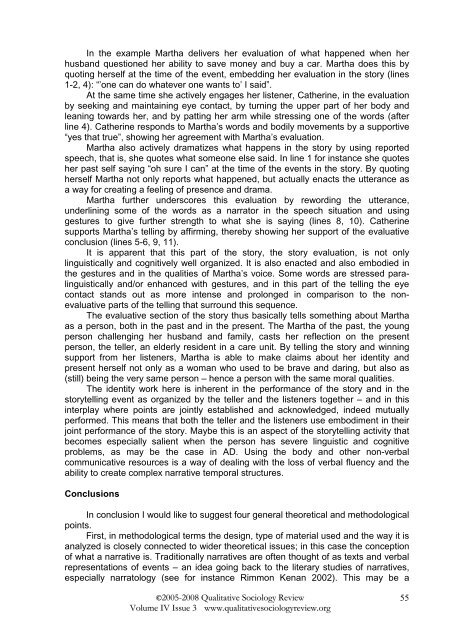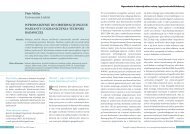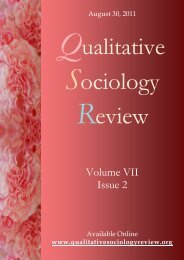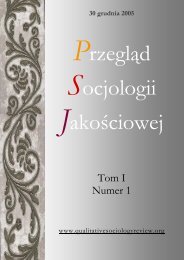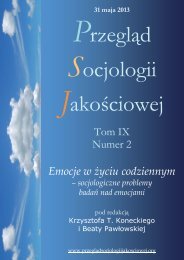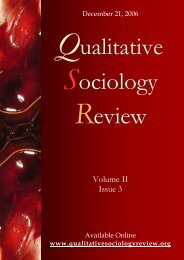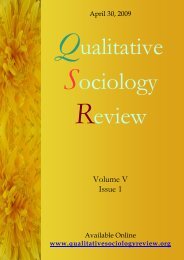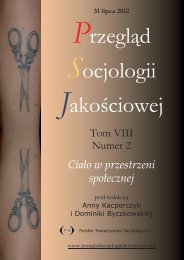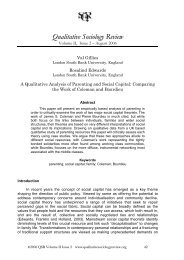volume IV is 3 - Qualitative Sociology Review
volume IV is 3 - Qualitative Sociology Review
volume IV is 3 - Qualitative Sociology Review
You also want an ePaper? Increase the reach of your titles
YUMPU automatically turns print PDFs into web optimized ePapers that Google loves.
In the example Martha delivers her evaluation of what happened when her<br />
husband questioned her ability to save money and buy a car. Martha does th<strong>is</strong> by<br />
quoting herself at the time of the event, embedding her evaluation in the story (lines<br />
1-2, 4): “’one can do whatever one wants to’ I said”.<br />
At the same time she actively engages her l<strong>is</strong>tener, Catherine, in the evaluation<br />
by seeking and maintaining eye contact, by turning the upper part of her body and<br />
leaning towards her, and by patting her arm while stressing one of the words (after<br />
line 4). Catherine responds to Martha’s words and bodily movements by a supportive<br />
“yes that true”, showing her agreement with Martha’s evaluation.<br />
Martha also actively dramatizes what happens in the story by using reported<br />
speech, that <strong>is</strong>, she quotes what someone else said. In line 1 for instance she quotes<br />
her past self saying “oh sure I can” at the time of the events in the story. By quoting<br />
herself Martha not only reports what happened, but actually enacts the utterance as<br />
a way for creating a feeling of presence and drama.<br />
Martha further underscores th<strong>is</strong> evaluation by rewording the utterance,<br />
underlining some of the words as a narrator in the speech situation and using<br />
gestures to give further strength to what she <strong>is</strong> saying (lines 8, 10). Catherine<br />
supports Martha’s telling by affirming, thereby showing her support of the evaluative<br />
conclusion (lines 5-6, 9, 11).<br />
It <strong>is</strong> apparent that th<strong>is</strong> part of the story, the story evaluation, <strong>is</strong> not only<br />
lingu<strong>is</strong>tically and cognitively well organized. It <strong>is</strong> also enacted and also embodied in<br />
the gestures and in the qualities of Martha’s voice. Some words are stressed paralingu<strong>is</strong>tically<br />
and/or enhanced with gestures, and in th<strong>is</strong> part of the telling the eye<br />
contact stands out as more intense and prolonged in compar<strong>is</strong>on to the nonevaluative<br />
parts of the telling that surround th<strong>is</strong> sequence.<br />
The evaluative section of the story thus basically tells something about Martha<br />
as a person, both in the past and in the present. The Martha of the past, the young<br />
person challenging her husband and family, casts her reflection on the present<br />
person, the teller, an elderly resident in a care unit. By telling the story and winning<br />
support from her l<strong>is</strong>teners, Martha <strong>is</strong> able to make claims about her identity and<br />
present herself not only as a woman who used to be brave and daring, but also as<br />
(still) being the very same person – hence a person with the same moral qualities.<br />
The identity work here <strong>is</strong> inherent in the performance of the story and in the<br />
storytelling event as organized by the teller and the l<strong>is</strong>teners together – and in th<strong>is</strong><br />
interplay where points are jointly establ<strong>is</strong>hed and acknowledged, indeed mutually<br />
performed. Th<strong>is</strong> means that both the teller and the l<strong>is</strong>teners use embodiment in their<br />
joint performance of the story. Maybe th<strong>is</strong> <strong>is</strong> an aspect of the storytelling activity that<br />
becomes especially salient when the person has severe lingu<strong>is</strong>tic and cognitive<br />
problems, as may be the case in AD. Using the body and other non-verbal<br />
communicative resources <strong>is</strong> a way of dealing with the loss of verbal fluency and the<br />
ability to create complex narrative temporal structures.<br />
Conclusions<br />
In conclusion I would like to suggest four general theoretical and methodological<br />
points.<br />
First, in methodological terms the design, type of material used and the way it <strong>is</strong><br />
analyzed <strong>is</strong> closely connected to wider theoretical <strong>is</strong>sues; in th<strong>is</strong> case the conception<br />
of what a narrative <strong>is</strong>. Traditionally narratives are often thought of as texts and verbal<br />
representations of events – an idea going back to the literary studies of narratives,<br />
especially narratology (see for instance Rimmon Kenan 2002). Th<strong>is</strong> may be a<br />
©2005-2008 <strong>Qualitative</strong> <strong>Sociology</strong> <strong>Review</strong><br />
Volume <strong>IV</strong> Issue 3 www.qualitativesociologyreview.org<br />
55


